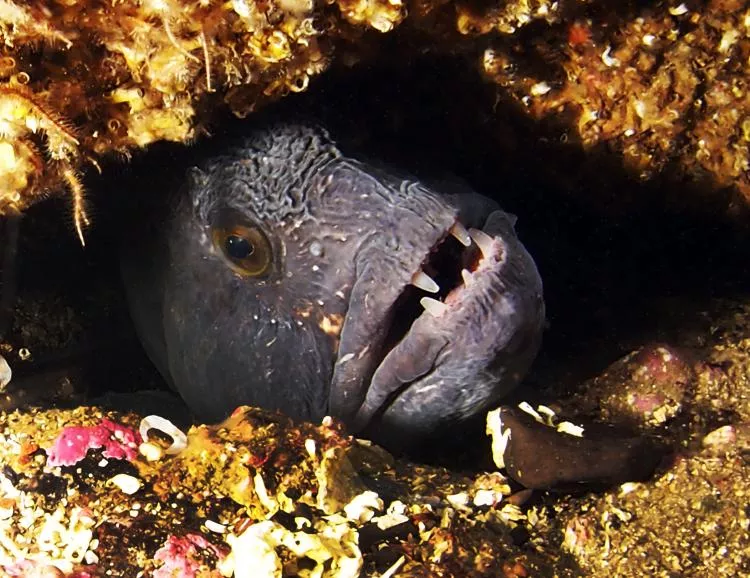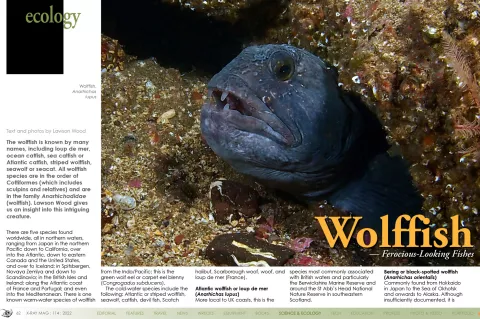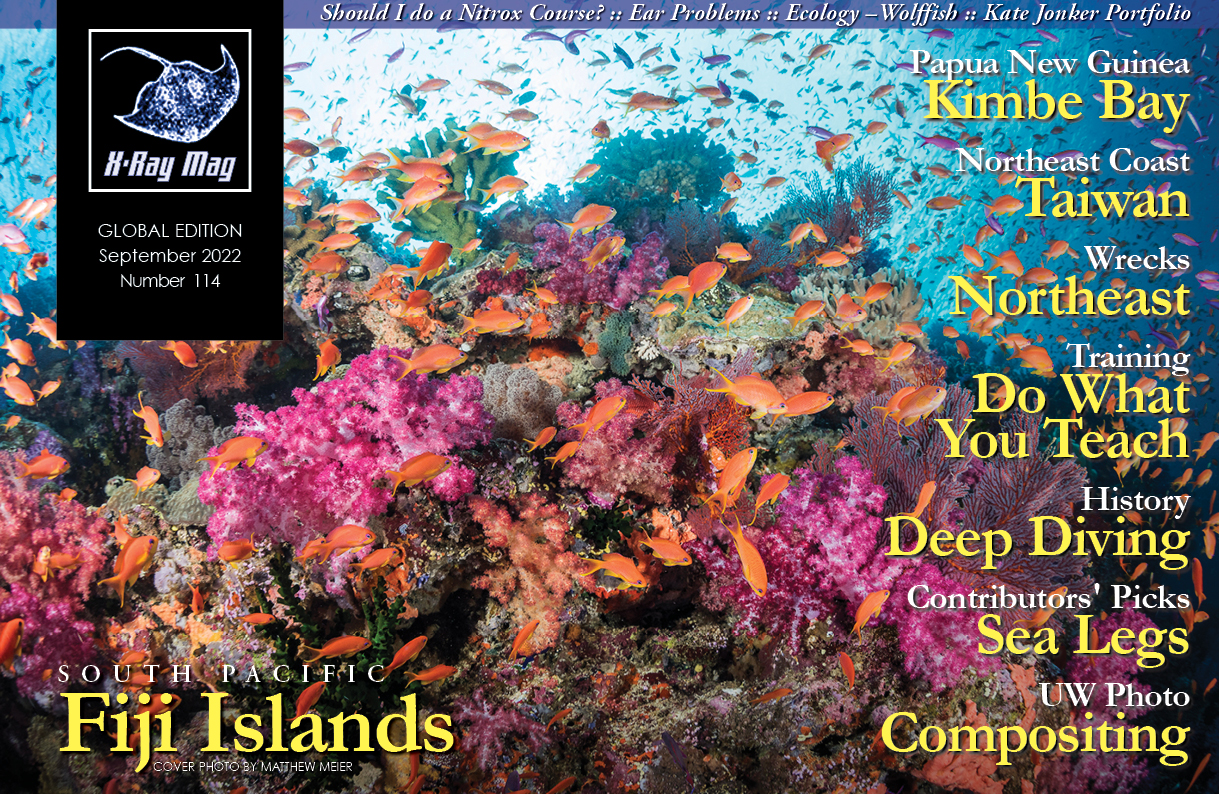The wolffish is known by many names, including loup de mer, ocean catfish, sea catfish or Atlantic catfish, striped wolffish, seawolf or seacat. All wolffish species are in the order of Cottiformes (which includes sculpins and relatives) and are in the family Anarhichadidae (wolffish). Lawson Wood gives us an insight into this intriguing creature.
Contributed by
Factfile
Location:
Admiralty Chart 115
Admiralty Chart 175 Fife Ness to St Abbs Head
Dive centre/air fills:
There is no longer a dive shop in Eyemouth, but air can be obtained at the following locations. (Please call in advance if you require air as staff at both businesses may not be available immediately, due to being out with their day dive boats).
Operators:
Dive St Abbs, Boat & Accommodation Rock House, St Abbs
(divestabbs.com)
Pathfinder, Boat and Accommodation, Priory View, Eyemouth Road, Coldingham (stabbsdiving.com)
Dive Stay at Eyemouth owns the Glenerne Guest House, the Home Arms Guest House and the Ship Hotel in Eyemouth. (divestay.co.uk)
Aquamarine Charters at Eyemouth is run by Derek Anderson. It has a couple of boats and visits the Black Carrs regularly. (aquamarine-charters.co.uk)
Marine Quest, Air, Boats and Accommodation, Harbour Road, Eyemouth (marinequest.co.uk)
There are five species found worldwide, all in northern waters, ranging from Japan in the northern Pacific down to California, over into the Atlantic, down to eastern Canada and the United States, and over to Iceland; in Spitsbergen, Novaya Zemlya and down to Scandinavia; in the British Isles and Ireland; along the Atlantic coast of France and Portugal; and even into the Mediterranean. There is one known warm-water species of wolffish from the Indo/Pacific; this is the green wolf eel or carpet eel blenny (Congrogadus subducens).
The cold-water species include the following: Atlantic or striped wolffish, seawolf, catfish, devil fish, Scotch halibut, Scarborough woof, woof, and loup de mer (France).
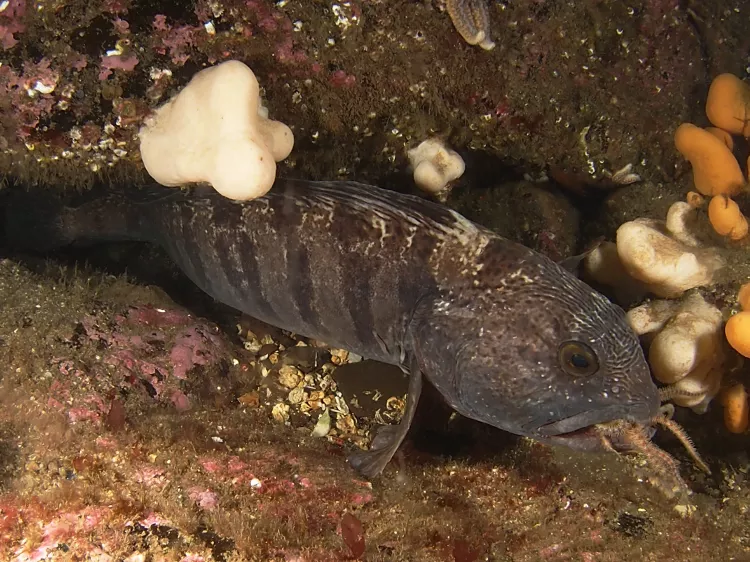
Atlantic wolffish or loup de mer (Anarhichas lupus)
More local to UK coasts, this is the species most commonly associated with British waters and particularly the Berwickshire Marine Reserve and around the St Abb’s Head National Nature Reserve in southeastern Scotland.
Bering or black-spotted wolffish (Anarhichas orientalis)
Commonly found from Hokkaido in Japan to the Sea of Okhotsk and onwards to Alaska. Although insufficiently documented, it is also known to occur across the northwestern Pacific, the Bering Sea and Arctic Ocean.
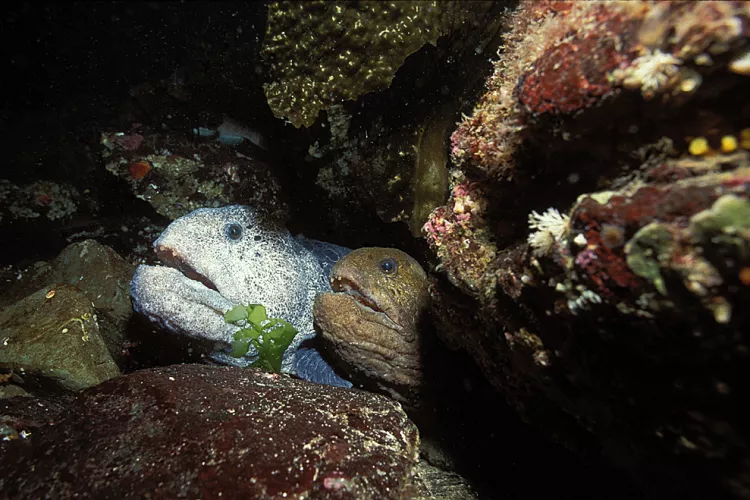
Wolf eel (Anarrhichthys ocellatus)
This large species is found in the northern Pacific, and I encountered this species at eastern Vancouver Island around Nanaimo. The males were a steely grey and the females a dull brown. Their lips were very pronounced around their elongated teeth. Usually over 2m long (6.5ft), the rear portion is quite tapered.
Northern wolffish (Anarhichas denticulatus)
Also known as the broadhead wolffish, bull-headed catfish, or catfish, this species is confined to the North Atlantic from Spitsbergen, and Scandinavia, south to the Faroe Islands and Shetlands, Greenland and southwest to Sable Island off Nova Scotia and the Grand Banks. It is very occasionally found in the North Sea, but surprisingly it is also found in deep waters in the Bay of Biscay. The head of this species is small compared to the rest of its body, which is quite rotund. It only grows to 144cm (4.7ft) long and weighs around 20 kilos.
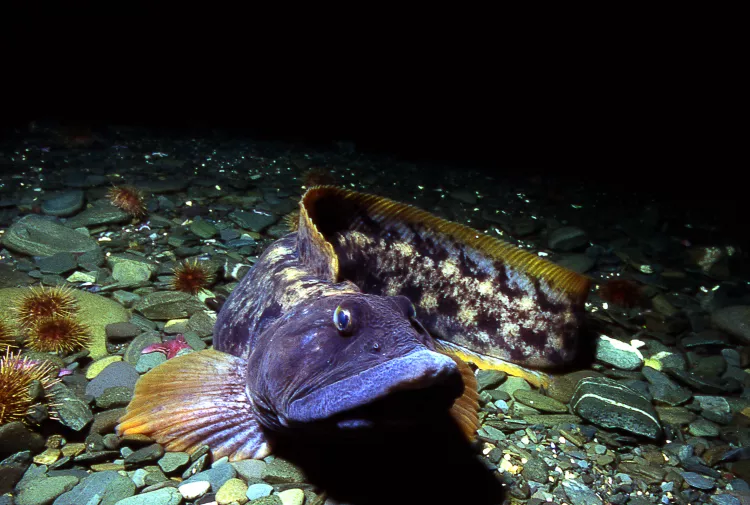
Spotted wolffish or leopardfish (Anarhichas minor)
This species is located off northern Russia and the Scandinavian coast, all the way to the Scotian Shelf off Nova Scotia. There have apparently been a couple of sightings recorded off southeastern Scotland and northwestern Ireland. I am not sure about these sightings as they appear quite far south, but like all animals and fish, they then turn up when and where you least expect them. This wolffish species is commercially raised by fish farms in the United States and Canada, which appears to be fairly successful as a percentage are being reintroduced into the wild. The body length is around 1.5m (5ft), and the head is in proportion to the rest of the body.
The wolffish is perhaps the most iconic of all the marine fish to be found within the Berwickshire Marine Reserve, located in the southeast of Scotland. I was instrumental in founding the first marine reserve in Scotland at Eyemouth, and around ten years later, co-founded the St Abbs and Eyemouth Voluntary Marine Reserve (now renamed the Berwickshire Marine Reserve). This marine reserve is now part of the Berwickshire and North Northumberland Special Area of Conservation—one of the largest marine conservation areas in Europe.
Characteristics
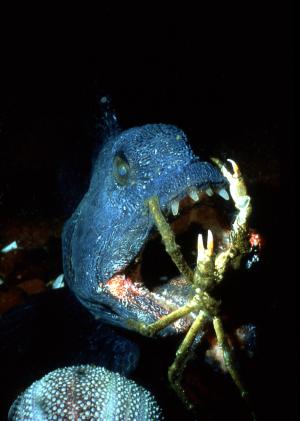
The wolffish’s Latin name, Anarhichas lupus, describes this fish as lupus (“like a wolf”) due to its very obvious and protruding teeth. The etymology, or route name Anarhichas, is from the Greek, Anarhichaomai, which means “to climb up,” suggestive of the species’ behaviour, as the fishes use their large pectoral fins to propel themselves over the seabed, and in and out of rocky crevices. They do swim, but in an undulating way like true eels!
These fish are well-named, quite obviously because of their protruding canine-like front teeth, which give them a ferocious appearance. But these fish are not aggressive at all; rather, they will shy away from divers’ lights and hide deeper inside their lairs.
Behind these visible primary canine teeth are a cluster of five or six smaller canines, as well as three sets of crushing molars on the roofs of their mouths, which they use to crush and pulverise their food. Their jaws are able to extend when attacking larger prey such as sea urchins, lobsters and crabs.
They are an Arctic species (and have a type of antifreeze in their bodies that keeps their blood flowing fluidly to withstand the sea temperatures below 0°C), preferring colder waters, and are more generally found from northern Norway down through Iceland; the Faroe Islands; Shetland and Orkney Islands, northern Scotland and all the way to the Farne Islands and perhaps farther south. There has been a verbal sighting off Tyneside and the Yorkshire Coast (but on a wreck well offshore a few years ago); but the farther south you go down the eastern coast of Britain, the rarer this species becomes as it ventures into warmer waters. However, there are always exceptions to every rule, and they have been fished off the coast of France, the Bay of Biscay, Portugal, and even the Balearic Islands in the Mediterranean.
Super-sized
This fish is actually a super-sized blenny, with a large round head, an elongated tapered body and a very long dorsal fin from just behind its head to its tail or anal fin. It has no pelvic fins but does have large pectoral fins situated just behind the gill covers, making this fish a blenny rather than some kind of eel. It uses these super-sized pectoral fins to allow it to “hop” over the seabed when searching for food.
It does have another cold-water close relative, which I photographed on Vancouver Island. With a face only its mother could love, this species is known locally as a wolf eel (Anarrhichthys ocellatus) and is usually found in waters of less than 18m (60ft). I found my pair of wolf eels in only 6m (20ft), but they can be found as deep as 330m (~1,000ft).
I am not sure whether the cold-water habitat has anything to do with the super-sizing of species, but when I visited Newfoundland, there is a species of eelpout that is equally as large as the wolffish, but not nearly as ferocious-looking, as it has large fleshy lips, not unlike the European eelpout or viviparous blenny (Zoarces viviparus). The term viviparous means “to bear live young.” The species found in Newfoundland is known as the large eelpout or Arctic eelpout (Lycodes lavalaei).
Behaviour
Often referred to as catfish or woof by fishmongers, wolffish are commercially caught, but usually as bycatch by bottom-trawling inshore fishing boats. Active feeders by night, they do rest during the day in rocky crevices or under boulders. At one particular site off the Black Carr Rocks just north of St Abbs Harbour, there is a rocky ledge in around 18m (60ft) of water where usually five or six wolffish can be found dotting the length of the ledge. The most that I have found there was eight, with another three nearby. Most scuba divers find wolffish along this stretch of coastline.
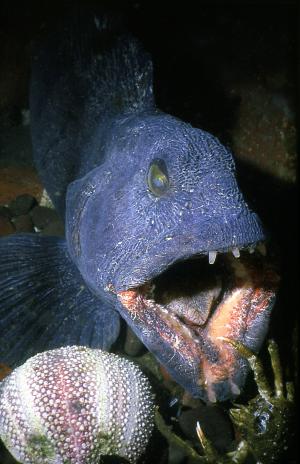
Encounters
I was first introduced to the wolffish back in the early 1970s when I first found one off Eyemouth (Scotland) in 12m (40ft) of water. Its right pectoral fin had been damaged and almost split in two, making the fish very distinctive. This was a huge wolffish with the head about the size of a football and easily over 2m (6.5ft) in length.
I had noticed some broken sea urchin shells and the remains of a few crabs near the entrance to its lair, when a large spider crab ambled past me as I was taking photographs of George (as we divers called him). George suddenly shot out and grabbed the spider crab in its mouth. When I went in closer to take the photograph, the wolffish was clearly intimidated by me and opened its mouth wide in an aggressive posture. The spider crab then climbed back out and ambled on its way!
This particular wolffish gained such notoriety that many divers and photographers (including shooters from the BBC) took the pilgrimage to Eyemouth for a face-to-face encounter with George! When feeding, wolffish are able to extend their jaws (similar to the wrasse species) and are easily able to engulf a large sea urchin whole.
Status
The Atlantic or striped wolffish is designated as being of “Special Concern” by SARA (Species At Risk Act) due its slow-growing, late maturation and living a benthic lifestyle where both adults look after the eggs. They should be returned to the sea, if possible, when caught as a bycatch and preferably in the area where they were fished, as they play an important role in the ecosystem of the ocean.
The Committee on the Status of Endangered Wildlife in Canada (COSEWIC) is an independent advisory panel to the Minister of Environment and Climate Change Canada and also refers to wolffish as threatened or endangered. The reason for their designation is that numbers have decreased over the last three generations, principally due to the seabed being altered by bottom dredging, ocean dumping and pollution, perhaps caused by environmental change and bycatch fatalities. Thankfully, the populations found in the Berwickshire Marine Reserve in southeastern Scotland appear to be fairly stable—for now.
Reproduction
At around the age of six years, when wolffish mature, they spawn during the winter months, laying over 1,000 large (6mm), yellowish eggs in small clumps attached to the rocky seabed, or in small crevices. The eggs are fertilised internally, and the parents take turns protecting the eggs and keeping them aerated (very similar to lumpsuckers). They also remove any diseased or dead eggs.
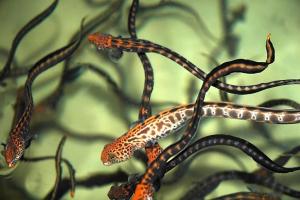
The eggs hatch after eight weeks or so, and the newborn hatchlings hide on the seabed amidst small stones, feeding on the last reserves of their egg yolks. They do have a larval stage and will float amongst that planktonic soup for a couple of weeks before settling onto a nice rocky seabed. Juveniles are olive-brown in colour with their pectoral fins being a shade of olive green. Adult females are usually more brown in colour, with the males a steely, purplish grey, with darker vertical bands down the length of the body.
Teeth
As they are a benthic (bottom-dwelling) species, they feed primarily on various crabs, sea urchins, starfish, mussels, whelks, cockles, clams, hermit crabs and other crusty critters. Like sharks, when the wolffish’s front teeth get worn down or broken off, they are replaced by a new tooth, which moves forwards from behind. Both the lower and upper jaws are armed with four to six conical teeth, which protrude forwards.
Behind the upper teeth are three rows of crushing teeth, in the centre of these are the pairs of molars on both the upper and lower jaws. The fish has a large tongue and even small, serrated teeth situated in the throat. The fish are known in Iceland and Norway as steinbítur or steinbit, the literal translation of which is “stone biter.”
When you look at the very young hatchlings and the size of their teeth as well as their long slim bodies, and then examine the skull of a mature wolffish, you can see that they could have easily been the inspiration for the creators of the movie Alien, so ferocious-looking are these fish in all stages of their lives. It is their aggressive posture and fearsome look that clearly identifies this massive fish, but they are really shy and retiring, and should not be coaxed out into the open by hand feeding!
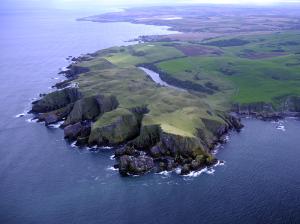
Where to see them in the UK
Now, more popular than ever, St Abbs on the southeastern coast of Scotland and within the Berwickshire Marine Reserve has become the epicentre for wolffish encounters. The Black Carrs, just north of St Abbs village, are only accessible by dive boat from either St Abbs or Eyemouth. Air and nitrox is available from the Home Arms Hotel and Marine Quest on Eyemouth Harbour.
Tidal considerations
There can be currents around the Black Carrs, and dive boats will endeavour to get you in the water at slack water and let you know which way the tide is running. It is recommended that you stay underwater until you are away from any shallower rocks before deploying your SMB and terminating your dive, as there may be other dive boats in the vicinity.

